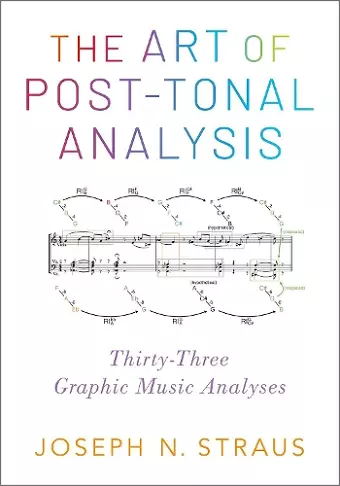The Art of Post-Tonal Analysis
Thirty-Three Graphic Music Analyses
Format:Hardback
Publisher:Oxford University Press Inc
Published:13th Jun '22
Currently unavailable, and unfortunately no date known when it will be back
This hardback is available in another edition too:
- Paperback£31.49(9780197543986)

The Art of Post-Tonal Analysis consists of analyses of thirty-three musical passages or entire short works in a variety of post-tonal styles. For each piece author Joseph N. Straus shows how it is put together and what sense might be made of it: how the music goes. Along the way, he shows the value of post-tonal theory in addressing these questions, and in revealing something of the fascination and beauty of this music. The works under study are taken from throughout the long twentieth century, from 1909 to the present. Within the atonal wing of modern classical music, the composers discussed here, some canonical and some not, represent a diversity of musical style, chronology, geography, gender, and race/ethnicity. Musical examples, plus a companion website full of analytical videos, carry the burden of the analytical argument, with rarely more than a few sentences of prose at a time. In writing these analyses, Straus imagined teaching these pieces to a class of undergraduate or graduate students, seated at the piano, pointing at score, listening as they go--the book is intended as a record of these (hypothetical) classes. His approach could be loosely described as transformational, rooted in an interest in seeing how musical ideas (shapes, intervals, motives) grow, change, and effloresce. When musical ideas are obviously dissimilar and possibly in conflict, the book teases out subtle points of connection between them. Above all, the book aims to create rich networks of relatedness, allowing our musical minds and musical ears to lead each other along some of the many enjoyable pathways through this challenging and beautiful music.
Joseph Straus, who has given us the classic text Introduction to Post-Tonal Theory, now provides a refreshingly diverse introduction to post-tonal repertoire. Concise multimedia analyses offer entry-points into pieces, composers, and analytical skills. These Graphic Music Analyses will be tremendously useful for teachers and students alike. * Daphne Leong, University of Colorado Boulder *
Equal parts brass tacks and fudge brownies, these analyses will challenge and delight. The repertoire is appealingly varied, the musical instincts spot-on, and the prose clear and compact. * Julian Hook, Jacobs School of Music, Indiana University *
Author of Introduction to Post-Tonal Theory (2016), Joseph Straus has gifted post-tonal pedagogues with this compendium that complements many of the concepts and analyses in his popular textbook. This text is unique in its assemblage of self-contained analytical vignettes, brought to life through multimedia. This last element-multimedia integration-makes the text particularly appropriate for use in the classroom. Those who engage this text without pedagogical intentions but, rather, for the pleasure of analysis itself will find Strausâs work enriching. He has placed great care into both selecting previously underappreciated works that provide opportunities for compelling interpretative arguments and reexamining familiar works through a fresh lens. There is something for everyoneâfrom the novice post-tonal instructor to the experienced analyst-to enjoy. * Gerardo Lopez, Integral *
Straus is... a leading authority on disability studies, and some of the features of the book and accompanying website seem designed to accommodate different learning styles...He also consistently uses analysis to support issues of interpretation, particularly of text-setting. * Christian Carey, Tempo *
Joseph N. Straus's most recent book is a masterclass in the pedagogical presentation of post-tonal analysis. Straus defines his approach within the domain of post-tonal theory, primarily focusing on pitch, through a lens that "could be loosely described as transformational". * David Floyd, Notes: the Quarterly Journal of the Music Library Association 81:1 *
- Winner of Winner, Pedagogy of Music Theory Award, Society for Music Theory.
ISBN: 9780197543979
Dimensions: 260mm x 183mm x 18mm
Weight: 531g
238 pages